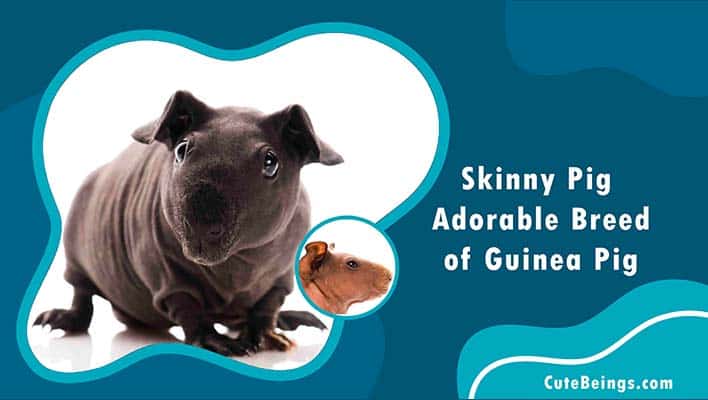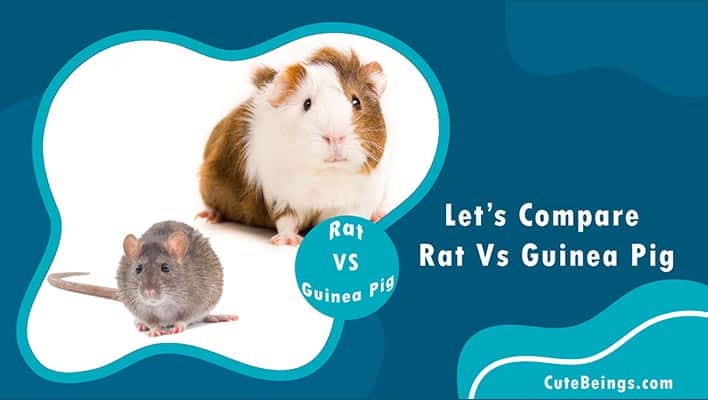When you imagine guinea pigs you picture them to have curvy bodies, cute noses and their thick glossy fur. Fur makes look guinea pigs full but just imagine them having all of that without the thick lustrous coat…”wait what, without the thick fur?” You might ask.
Yes, you just imagined a skinny pig. Some of them don’t have hair at all while some are having very little hair. For those who suffer from allergies hairless guinea pig make a perfect match as a pet.
As skinny pig is new to animal world, they are becoming popular among pet lovers in recent era but not much as their relatives with hair. Try these facts if you really keen to find out more about these charming social animals.
Table of Contents
Facts about Skinny Pig
- Belongs to caviide family
- Rodents in order and belongs to cavia group
- Skinny pigs live around 4 to 7 years
- Skinny pig’s pregnancy period would be roughly 63 days
- Habitat mainly indoor and need to keep them warm
Having a skinny pig really depends on individual’s desire as this variety is unique from furry guinea pigs. If you want to try something new and interesting, having a hairless guinea pig would be your wise choice as even this could become good conversation starter for you because other pet owners and animal lovers will love to hear about other guinea pigs.
Did I mention you the best part of having hairless guinea pigs? Well, you don’t have to brush them daily at all and just forget about grooming. Skinny pig is just like any other rodent dynamic, fun loving and adoring.
Origin of Skinny Pig
Skinny pigs surely didn’t have a natural kick off. There is a slight dispute about establishment of hairless guinea pigs. Peru is the native place of guinea pigs and they have been descending since 5000 BC while hairless guinea pigs were bred specifically in a Montreal laboratory just about 40 years ago.
After series of careful breeding process a colony of genetically mutated guinea pigs was bred in a laboratory in 1978. The consequence of this spontaneous genetic mutation was hairlessness and researchers were as eager about this hairless guinea pigs as they didn’t expect this to happen. This could be due to controlled hormone levels.
These skinny pigs were originated to keep the strain going, later haired guinea pigs were also added to the breeding program. It explains that first hairless guinea pigs strain had some immunity and health problems.
Present Status Of Skinny Pigs
Through continuous researches after almost 40 years the hairless guinea pigs strain has developed loving and healthier hairless guinea pigs to the pet world and nowadays skinny pigs are mostly used for dermatology studies as well.
Appearance Of Hairless Guinea Pigs
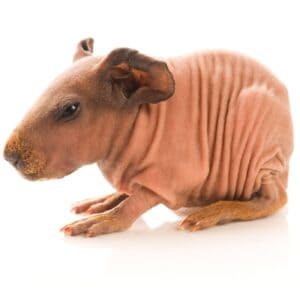
Though we said hairless skinny pigs, they do have some fuzzy hair on their muzzles in legs and feet. Apart from that they do not have hair over the rest of the body. Occasionally you will find some skinny pigs with a thin layer of hair on their backs.
Hale and hearty skinny pigs have smooth skin with some wrinkling around neck and legs. You won’t be able to find spine or ribs and body would be full.
Special Attention
You need to protect your pet skinny pig from direct sunlight as these skinny pigs have outsized patches of plain skin. If they are exposed to sunlight they could easily get sun burns or skinny pig’s body could be damaged.
Also it makes harder for these guinea pigs to normalize their body temperature. As a result of those they could suffer from dry skin and could easily be a target of mites.
Various Sizes Of Skinny Pigs
Regular guinea pig usually has a typical length of 10 inches or 25 centimeters. Even hairless skinny pigs are very similar to normal guinea pigs with more hair in length but as skinny pigs have no hair, they are slightly smaller in size.
Lab bred other guinea pigs versions are exceptionally cute but these animals likely to have shorter expectance of life.
Usually a skinny pig is 3-4 inches long at birth, growing to 5-6 inches within 7-8, then 7-8 inches by 15-16 weeks. Once the hairless baby skinny guinea pigs are mature they will be around 10 inches in length.
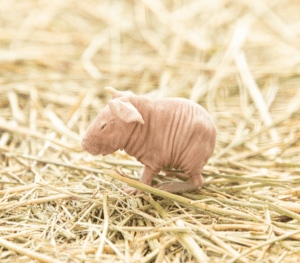
There could be various factors that could affect the overall size of skinny pig such as skinny pig’s diet, their health, living conditions and any sickness skinny pigs might have or catch.
These affect not only for skinny pigs but also for normal guinea pig as well and these can easily change the overall size of your pet guinea pig.
Health Issues Of Hairless Guinea Pig Breed Skin And Skin Condition
Exposed skin: Regular haired guinea pigs receive great protection from fur coat and a haired guinea pig would never get a scratch or scrape.
But such situations could be difficult and different for hairless pigs who have a sensitive skin as there is no hair covering their most exposed parts.
Skin conditions: Normally all the guinea pigs are vulnerable to catch skin sickness. Especially hairless piggy’s sensitive skin makes it worse than others.
Hairless guinea pigs can have skin conditions such as parasites, ringworms and other skin infections like fungal infections. So always pay attention to your hairless guinea pig and it’s body condition especially skin.
Sensitivity
Sensitiveness: skinny guinea pigs are massively sensitive to their environment or the habitat than most guinea pigs. They can be easily irritated by wood chips so make sure their habitat is safe for them to live on.
Also hairless guinea pig is very sensitive to cold as it hardly has a thin covering in certain areas. Hairless strain find it difficult to maintain body heat unlike their hairy cousins.
How You Keep Your Skinny Pig Out Of Harm’s Way
After all these years skinny pigs have become healthier than before but they still have need of special care. As they are short of fur coat, they will catch cold easily so you must keep them as an indoor animal.
Skinny pigs must be kept indoors and in a warm environment to maintain internal temperature due to their spontaneous genetic mutation.
As they have some hair only on their noses and feet you should care a lot about them, not to catch cold or from hypothermia as they don’t have fur to protect them from cold weather.
Generally speaking you need to ensure that their indoor cages are pleasurable places to live in and warm so they don’t feel cold. Make sure to keep it tidy as well so their skin condition will be perfect.
In hot weather you need to keep an eye on your skinny pig so they won’t get any sun burns. If you are planning to take them out for a change make sure you apply some sun cream on their sensitive skin especially on face and be aware not to apply any on their eyes.
Nutrition For Skinny Pig Breed
Usually a skinny pigs eat more than a normal guinea pig so offer enough fresh vegetables, leafy greens, timothy hay and all the nutrition including vitamin C they require for their well being and skinny pigs have a great functioned metabolism system as skinny pigs’ bodies work harder to keep them warm. Keep their food bowls full so they can consume enough food.
Naturally, their bodies produce some oils to protect the skin and they do need that protection so you don’t have to bathe them regularly as regular guinea pigs. Always remember natural ingredients are always better than artificial subsidiaries for your perfect pet.
Cage

Basically each pet guinea pig requires at least 7.5 square feet of space and if you are willing to keep two skinny pigs as a cage mate or few at a time you will need quite a large tank. Entire life they take pleasure in exploring horizontal space.
They are also enjoying walking up and town different levels. So try to have a wide and tall tank so that will give them an enjoyable experience.
They also like to play with toys so give them plenty. You can fulfill their need of horizontal space by taking them out from the tank and letting them run around.
If you provide them spacious tank your rodent will able to separate its bathroom area from the rest of the tank. It will help you to keep the cage clean as it makes lot easier to clean while your pet will be in a healthier condition.
Temperature

Skinny pigs find it difficult to control their body heat as they don’t have much fur. So you need to keep its cage’s optimal temperature range between 65° and 75°F as they can stay warm.
Also keep the cage away from direct sunlight, vents or fire places as these could influence their core temperature.
Bed Linen
Make it comfortable by placing sufficient substrate lining to the bottom of the cage so they can crawl in when they feel cold.
How to choose proper bed linen
When you pick lining, pick from paper shaving or comparable products and don’t choose cedar or pine contained chemicals which could be harmful to your pet.
Though your skinny pig doesn’t eat them, the vapors can be injurious to their respiratory system and they could easily catch respiratory infections than other injuries.

Needs
As this domesticated pet animal is not nocturnal it doesn’t really prefer any particular lighting needs as other regular guinea pigs. Keep them in a place where they can see sun rise and sun set and that will avoid the need of any artificial manipulation to their light disclosure.
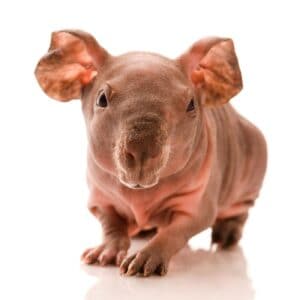

Hello, my name is Michelle and I’m a pet lover. For the past 12 years, I’ve been caring for pets. As a result of this, I decided to share my personal experience with you.

